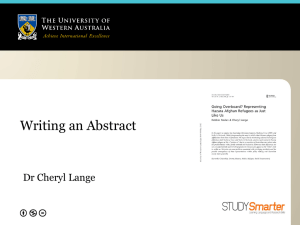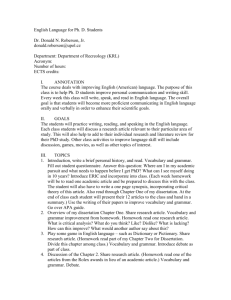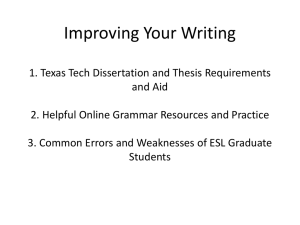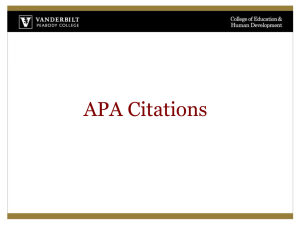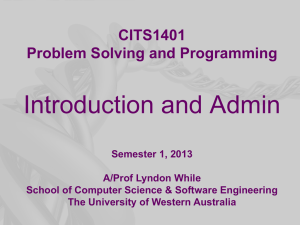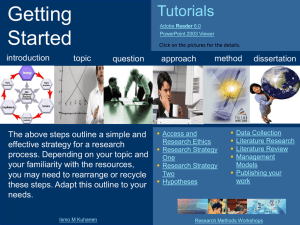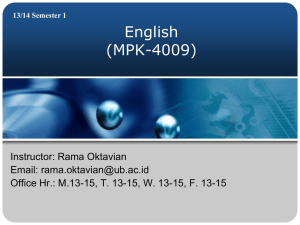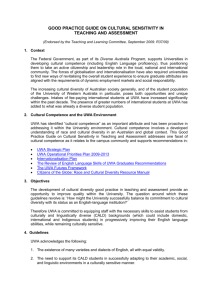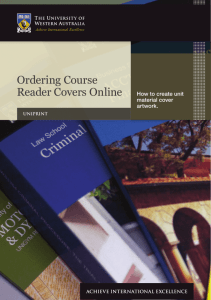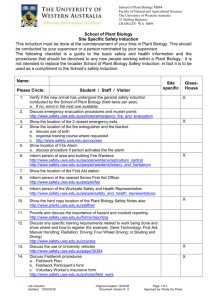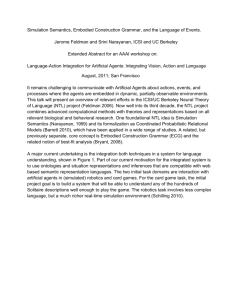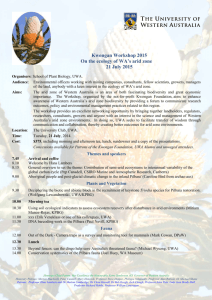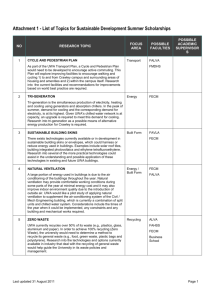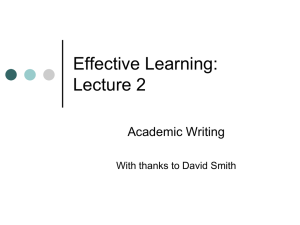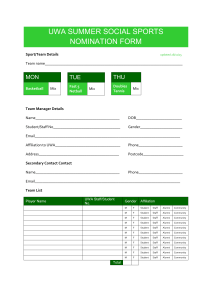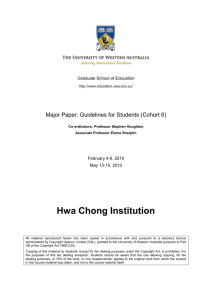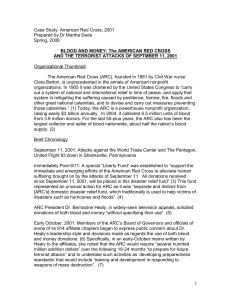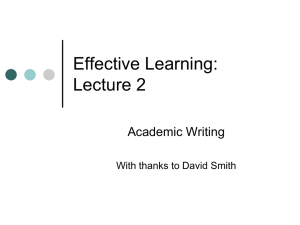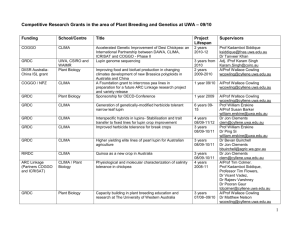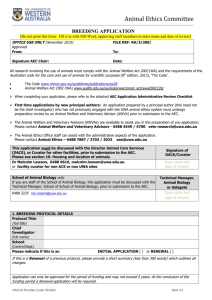Main Heading - Current Students
advertisement
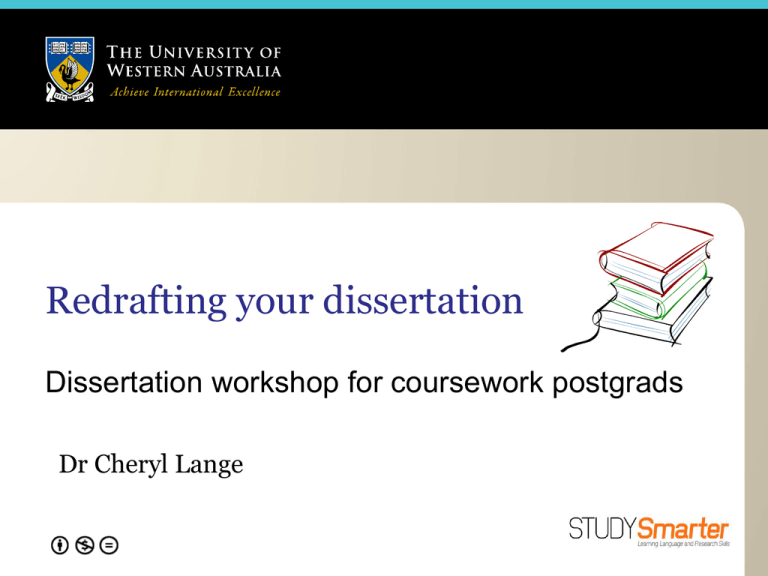
Redrafting your dissertation Dissertation workshop for coursework postgrads Dr Cheryl Lange You’ve finished the first draft - well done • Don’t race off to show it to your supervisor yet. • There are still a couple of important things you need to do. Set aside your work for a few days Redraft Many ideas in this presentation are adapted from Evans, D & Gruba, P 2002 (2nd ed.) How to write a better thesis, Melbourne, Melbourne University Press, pp. 123-139. Things to check 1. Structure 2. Spelling, grammar, punctuation, formatting, etc. Structure – some questions • Is there a table of contents? (check that there is agreement between the table of contents and your chapter headings) • Does the Introduction mention – – – – why the research was done what the aim is how the aim was achieved what the scope of the dissertation is? • Do the conclusions correspond with the aim? Note areas to be improved in the margins of the text Redraft questions – ask yourself • Does the logic of my argument flow from introduction to conclusion? (If not, fix up any gaps, repetitions, problems with order, etc.) • Has my aim shifted during my research? (If yes, re-write your aim.) • Is there material in the body that would be better off in an appendix? (If yes, move it to an appendix.) • Have important points emerged that I didn’t consider when structuring my first draft? (If yes, work out how/where to incorporate them.) Results – more questions • Are the results of my experiments, interviews or other aspects of my own work clearly presented and explained? • Am I discussing the implications of my results as I go? (OK if you are doing a dissertation in the humanities and some social sciences. NOT OK, for dissertations in physical, biological sciences.) Discussion and Conclusions • Have I discussed my findings in terms of improving or extending current theory or practice? (This may not be necessary for some coursework dissertations.) • Do my conclusions follow on from my discussion? (They should.) • Have I introduced new discussion topics into my conclusion? (If yes, you will have to rewrite your discussion to include the new ideas or rewrite your conclusion and leave them out.) • Do my conclusions explain the implications of my work for theory or practice or provide recommendations? (They should, depending on your dissertation requirements.) More redrafting questions • Does my formatting confirm to the specifications of my unit/discipline? • Have I checked my spelling thoroughly (don’t rely solely on spell check) • Does my punctuation help the reader understand my various points of view? • Have I labelled all my tables and figures correctly? • Have I meticulously checked my referencing? Redrafting takes time but it MUST be done Redrafting your Abstract 1. Have I stated briefly what my research is about? 2. Have I included my research question? 3. Have I contextualised my research in terms of previous studies? 4. Have I stated why my research is important, e.g. what gap or limitation it is addressing? 5. Have I reported my findings? 6. Have I mentioned the major conclusions and /or implications of my findings for my field of research? 7. Have chosen the most appropriate key words? What’s a good title? • [T]he fewest possible words that adequately describe the contents of the paper1. • It’s catchy, yet informative. • It summarises what you found, not what you did. 1. Day,RA 1983 How to Write and Publish a Scientific Paper, (2nd edn), ISI Press, p. 9. Effective titles Compare – which is more effective? 1.Lamb loses more moisture during cooking than mutton. 2.Studies on the cooking of lamb and mutton. Adapted from http://www.science.uwa.edu.au/students/assignments-exams More examples •Becoming sinless : converting to Islam in the Christian Solomon Islands (D. McDougall) •Loss in anchor embedment during placement anchor keying in clay (Z. Song) Want to impress your examiners? Use a clear, direct writing style Tips for writing concisely Circle the prepositions (of, in, about, for, onto, into) Draw a box around the "is" verb forms Ask, "Where's the action?” Change the "action" into a simple verb Move the doer into the subject (Who's kicking whom) Eliminate any unnecessary slow wind-ups Eliminate any redundancies. http://owl.english.purdue.edu/owl/resource/635/1/ An example • http://owl.english.purdue.edu/owl/resource/635/1/ More help? • See Guide to Grammar and Writing Concise Sentences for lists of redundant phrases: http://grammar.ccc.commnet.edu/grammar/concise.htm • About.Com Grammar and Compositions lists 200 Common Redundancies: http://grammar.about.com/od/words/a/redundancies.htm Drop in 1pm-2pm daily during teaching weeks Reid Library - Mon, Wed, Thurs Science Library – Tues, Fri Writing Clinics Tues and Fri 10 am – 12 noon Generic study skills workshops Mon – Thurs usually between 11am - 2pm Individual consultations – make your appointment and submit your draft at least 2 days prior to when you want your consultation. Contact details Phone: 6488 2423 - Student Support Reception www.studysmarter.uwa.edu.au study.smarter@uwa.edu.au www.lace.uwa.edu.au cheryl.lange@uwa.edu.au
